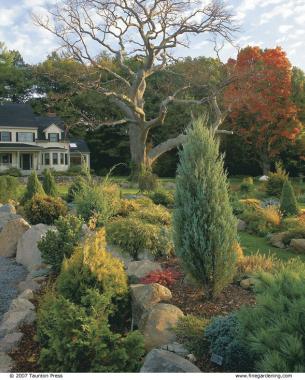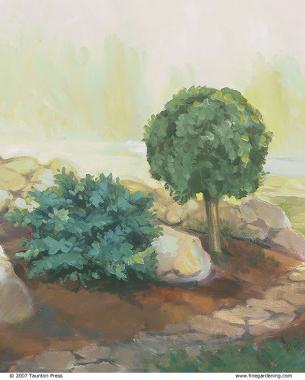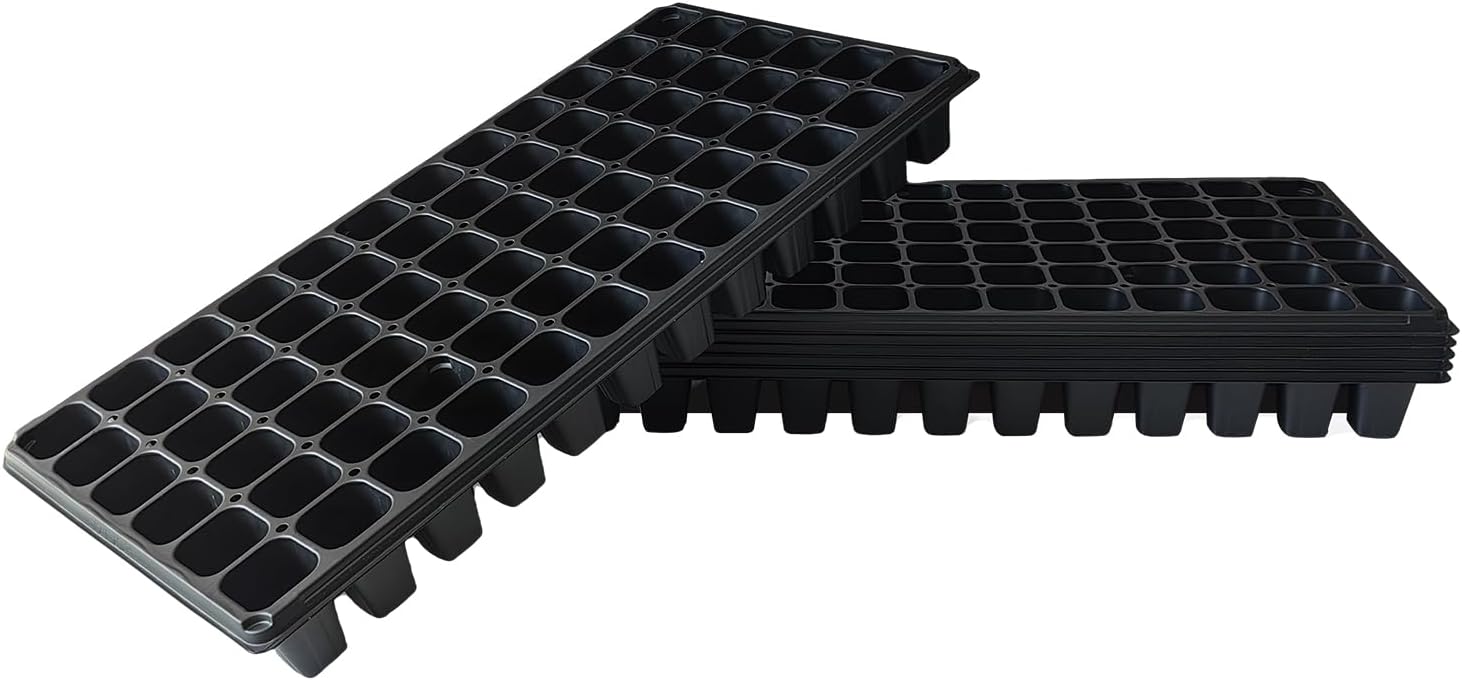
When my husband and I built a new house filled with large windows, I wanted beautiful views all year-round. Perennial borders were my first choice, until I remembered that they require intensive maintenance and that they often fall far short of gorgeous during the winter. Then I thought of evergreens—they don’t need much care, they’re hardy, and they look beautiful no matter what the season. Even in the bleakest winter, the garden looks like a garden—thanks to the conifers.
Since then, I have discovered that evergreen conifers can be useful in almost any garden design. I find them unexcelled as privacy screens or foundation plantings, as backgrounds for flower borders, as specimens, and as accents in the smallest rock gardens or at the edge of vast forests.
By the time I moved to an old-fashioned farmhouse in Hamilton, Massachusetts, six years ago, I liked conifers enough to dig as many as I could from the old house in New York and deliver them to my new home near Boston. After piloting nine large truckloads of evergreens across southern New England, I could hardly wait to begin planting a new garden, one that would incorporate everything I had learned about designing with conifers.
Choose conifers in sizes that fit the scale

The first step in creating a conifer-rich planting is deciding how big to make the garden. That done, I select conifers to complement its size. Small gardens or rock gardens work with small, slow-growing, dwarf or miniature trees. Larger gardens can accommodate intermediate-sized or large trees.
That said, I never allow a garden’s size to be the sole determining factor in selecting plants. I also consider the role the planting will play. A wide privacy screen requires large trees, even if the planting area is relatively small. And in even the biggest rock gardens, a full-sized tree looks out of place.
Since I am unable to resist the attractions of all kinds of conifers, I decided to create two separate plantings, each on a scale of its own. One would be a big, semicircular bed with large evergreens—white pines, Norway spruce, Frasier firs— standing at the back of the bed to serve as a screen along my property line and to create a background for intermediate-sized conifers planted in front (photo at right). For the smaller-scale garden, I planned an array of free-form, raised beds planted with miniature and dwarf conifers, as well as ground-hugging perennials. Curving paths would thread between the smaller beds, making it easier to view the plants.
Silhouettes define a conifer’s shape
After deciding what size conifers to use, I had to start thinking about using them in combination with each other. Doing it well can be difficult; conifer colors are subtle, and their shapes never really change. A conifer shaped like a Christmas tree looks like a cone whether it’s five years old or 50 years old.
For a designer, those unchanging shapes are both charming and challenging. The trick is turning those static forms into dynamic compositions. It’s almost like creating a sculpture. For me, the whole secret lies in juxtaposing shapes so that the individuality of each tree or shrub is accentuated by its nearest neighbors.
That’s not as difficult as it sounds. It’s just a matter of mixing shapes. And luckily, nearly all conifers take one of four basic shapes. Except for weeping varieties and a few irregular cultivars, most conifers can be roughly classed as flat, round conical, or cylindrical. “Roughly” is the key word; I always allow for some variation. But for simplicity’s sake, I still think of both a ball-shaped false cypress and a moundlike ‘Blue Star’ juniper as being basically round.
To make understanding the shapes even simpler, I find it useful to think of them as silhouettes. Then I need consider only the straight or curved lines that define their margins. If the plant’s lines are horizontal, it’s a flat, ground-hugging variety, such as a ‘Blue Carpet’ juniper. If they are upright and nearly parallel, the tree is a cylinder, like a ‘Moonglow’ juniper. If the lines form an upside-down “V” and are simply a pair of slanted straight lines, it’s a cone-shaped tree, one that looks like a Christmas tree. Finally, if the silhouette is composed of curved lines that form a circle or oval, the conifer is one of the round varieties, like a ‘Montgomery’ blue spruce. Once you understand the shapes, making eye-catching combinations is easy.
Blend sizes and shapes to create visual interest in the garden
To me, a successful planting of conifers is like the skyline of a great city—a creative, eye-pleasing blend of varied sizes and shapes. Close-up views reveal the essence of an individual tree or building by baring its shape, color, and texture. But when seen from a distance, the colors and textures fade. Shapes dominate. And those contrasting shapes are what provide the drama and sense of wonder I so often experience when viewing a majestic city skyline—or a great planting of conifers.
Just as buildings are the architectural building blocks of a city, conifers are the structural backbone of a garden. And because the view of a conifer bed is usually a “skyline” view—they are often seen from a distance—shape is my primary consideration when designing a new planting.
Design for maximum contrast


My guiding design principle for combining those shapes is to seek maximum contrast. For me, the most vivid and pleasing picture results when no two similar shapes are placed next to one another. I like to work with small groupings, and take care to make each conifer as different as possible from its neighbors. One of my favorite compositions, for example, began with a ‘Montgomery’ blue spruce, one of the round conifers. I wanted to place something cone-shaped next to it, so I added the broadly conical hinoki cypress ‘Nana Lutea.’ Then, to maximize the contrast, I planted a flat, ground-hugging Japanese juniper (Juniperus procumbens ‘Nana’). For a more vertical composition, I could have used a cylinder-shaped conifer instead.
I like to maximize contrast in conifer groupings by also varying the colors of each adjoining conifer. Many are available in three or four shades each of green, blue, and yellow. I also consider more elusive qualities, such as the texture of the foliage and the habit of the conifer. Some are airy and open, for example, while others are dense and compact.
To make sure I’ll like a combination, I experiment before planting. Since conifers usually come from the nursery in containers or balled and burlapped, it’s easy to arrange and rearrange them—even at the nursery.
Size is the one characteristic to keep more or less consistent in a conifer planting. You don’t want to plant a 12-inch-tall miniature next to something that will grow to a height of 50 feet or more. Still, you can mix and match a little. In small planting beds, I use mainly miniatures and dwarfs, but I’ve discovered that intermediate-sized ground-huggers or slim cylinders serve well as accents because they never get too massive.
Fill out a bed of conifers with perennials
When planting, I’m always careful to leave plenty of room between each conifer. Generous spacing eliminates the need to move a crowded conifer after a few years. More space also allows better air circulation and thus promotes healthier growth. The most important reason for generous spacing, however, is aesthetic. I think the beauty of a conifer’s shape is diminished if nearby plants obscure their silhouettes.

But if the new plantings are properly spaced, the garden may look rather sparse. I use perennials to fill some of the empty spaces and to contribute extra color. I especially like vigorous ground-huggers, since they don’t intrude on the conifers’ more lofty domain. High on my list is almost any thyme (especially ‘Mother of Thyme’ and woolly thyme). I also like Gypsophila repens, which comes in pink or white.
A few taller accent plants complement rather than compete with conifers. Among my favorites are pasque flowers (Pulsatilla vulgaris), whose extra-early blooms come in white, purple, or wine. They have long-lasting, fluffy seed heads, and lacy foliage that remains attractive until frost. Near all but the tiniest conifers, Sedum ‘Autumn Joy’ and dwarf fountain grass (Pennisetum alopecuroides ‘Hameln’) make enhancing, not overpowering, companions.
Conifers shine through four seasons

Conifers are the kings of all foliage plants, no matter what the season. In spring, the colors of their new growth seem extra rich because there are few flowers to compete. Later, they provide a backdrop for splashy, summer blooms. Conifer colors take on a renewed glow in fall, when their greens, blues, and yellows contrast marvelously with autumn reds and yellows.
Even in the dead of winter, conifers shine. Lightly etched with a dusting of powder or bent under wet snow, the fairyland created by their wonderful shapes enlivens the short, dark days. I am amazed, year after year, at the way conifers seduce me in each new season.
Conifers by shape, color, and size


Conifers come in four basic shapes: round (or mounded); flat, ground-hugging; conical; and cylindrical. Combining those shapes to heighten the contrast between them creates dynamic compositions in the garden. Greater effects are possible when conifer color variations—ranging from golden yellow to silvery blue—are incorporated in a grouping of plants.
Strong contrasts of shape and color can be effective, but it is best to avoid extremes in the size of adjacent plants. Conifers exhibit four distinct growth habits: miniature, dwarf, intermediate-sized, and large. Growth patterns are usually found on the plant’s nursery tag. Miniatures grow no more than 3 inches a year and reach a maximum height of 3 feet within 10 years. Dwarfs grow up to 6 inches in a season, and in 10 years reach a height between 3 and 6 feet. Intermediates grow up to a foot a year and, in a decade, top out at somewhere between 6 and 15 feet. Large conifers grow a foot or more a year and reach heights in excess of 15 feet in 10 years. These are rough guidelines, since growth rates are greatly affected by your USDA Hardiness Zone, microclimate, soil, and growing conditions.
Here are some of my favorite conifers:
Round or mounded
Chamaecyparis pisifera ‘Filifera’ (green; intermediate)
C. pisifera ‘Filifera Aurea Nana’ (yellow-green; intermediate)
C. pisifera ‘Golden Mops’ (yellow; dwarf)
Juniperus squamata ‘Blue Star’ (soft steel-blue; dwarf)
Picea pungens ‘Montgomery’ (blue; dwarf)
Pinus mugo ‘Valley Cushion’ (medium-green; miniature)
Thuja occidentalis ‘Rheingold’ (golden-yellow; dwarf)
Flat, ground-hugging
Juniperus horizontalis ‘Blue Chip’ (blue; intermediate)
J. horizontalis ‘Mother Lode’ (yellow to bronzy in winter; dwarf)
J. procumbens ‘Nana’ (rich green; intermediate)
Microbiota decussata (green, bronze in winter, intermediate)
Picea alcoquiana ‘Prostrata’ (green-and-blue bicolor, miniature)
P. pungens ‘Glauca Procumbens’ (blue; dwarf)
Conical
Abies lasiocarpa ‘Glauca Compacta’ (blue; dwarf)
Chamaecyparis obtusa ‘Nana’, and ‘Nana Gracilis’ (dark green; miniature, dwarf, respectively)
C. obtusa ‘Nana Lutea’ (yellow; dwarf).
Picea glauca ‘Conica ’ (bright green; dwarf)
P. glauca ‘Rainbow’s End’ (creamy yellow tips, green inside; dwarf)
P. orientalis ‘Skylands’ (also ‘Aurea Compacta’) (yellow; intermediate)
Cylindrical
Juniperus chinensis ‘Aurea’ (golden-yellow; dwarf)
J. communis ‘Compressa’ (green; dwarf)
J. communis ‘Hibernica ’ (green; intermediate)
J. communis ’Sentinel’ (syn. ‘Pencil Point’) (silvery-gray; dwarf)
J. scopulorum ‘Moonglow’ (blue; intermediate)
Conifers on display
With so many varieties, shapes, sizes, and colors—and so few good references—the best way to become acquainted with conifers is to see them displayed in a garden. The following public sites have been selected for their conifer collections.
EAST
Arnold Arboretum at Harvard University, Jamaica Plain, MA
www.arboretum.harvard.edu
Atlanta Botanical Garden, Atlanta, GA
www.atlantabotanicalgarden.org
Longwood Gardens, Kennett Square, PA
www.longwoodgardens.org
North Carolina State University Arboretum, Raleigh, NC
www.ncsu.edu/jcraulstonarboretum/index.php
United States National Arboretum, Washington, DC
www.usna.usda.gov
CENTRAL
Bickelhaupt Arboretum, Clinton, IA
www.bickarb.org
Chicago Botanic Garden, Glencoe, IL
www.chicago-botanic.org
Dawes Arboretum, Newark, OH
www.dawesarb.org
Hidden Lake Gardens, Tipton, MI
hiddenlakegardens.msu.edu
Morton Arboretum, Lisle, IL
www.mortonarb.org
Royal Botanical Gardens, Hamilton, Ontario, Canada
www.rbg.ca
WEST
Hoyt Arboretum, Portland, OR
www.hoytarboretum.org
Mendocino Coast Botanical Gardens, Fort Bragg, CA
www.gardenbythesea.org
Strybing Arboretum and Botanical Gardens, San Francisco, CA
www.sfbotanicalgarden.org
University of California Botanical Garden at Berkeley at Centennial Dr., Berkeley, CA
http://botanicalgarden.berkeley.edu
Van Dusen Botanical Display Garden, Vancouver, British Columbia, Canada
www.city.vancouver.bc.ca/parks/parks/vandusen/website/
Fine Gardening Recommended Products

Deep 72 Cell Seedling Trays (10-Pack)
Fine Gardening receives a commission for items purchased through links on this site, including Amazon Associates and other affiliate advertising programs.

A.M. Leonard Deluxe Soil Knife & Leather Sheath Combo
Fine Gardening receives a commission for items purchased through links on this site, including Amazon Associates and other affiliate advertising programs.

Planting in a Post-Wild World: Designing Plant Communities for Resilient Landscapes
Fine Gardening receives a commission for items purchased through links on this site, including Amazon Associates and other affiliate advertising programs.


















Comments
Thank you for all the info in this page. I took notes and saved your photos because I have been wanting to make a flower bed with exactly these plants you have listed.
I want to throw in ornamental grasses as well as Boxwoods and such.
I had the pleasure of visiting the D.C. Arboretum last year for landscaping ideas.
Thank you!
Launched in January 2015, Nutaku is an online game portal dedicated to bringing the highest quality games to our committed fans. ... Our company provides a host of services for game developers, ranging from well-established studios to newly created startups. https://uttercoupons.com/front/store-profile/nutaku-coupons
We are livecoupons.net. Best place for unique garden.
Check my blogs at https://www.savewithblogs.com/ for your dream garden.
Log in or create an account to post a comment.
Sign up Log in